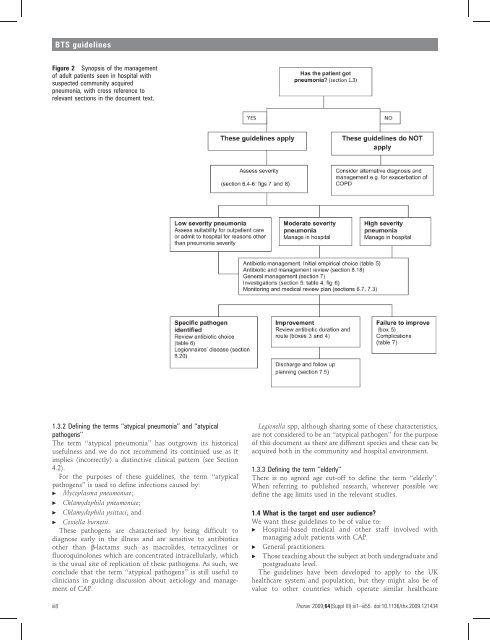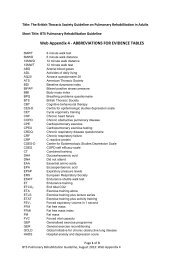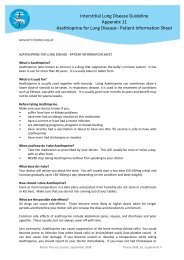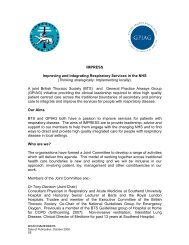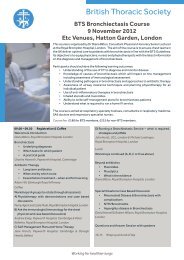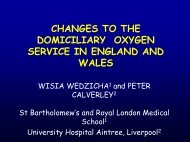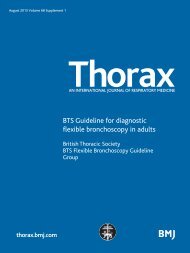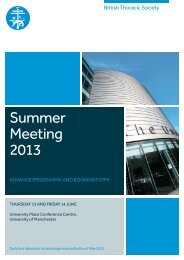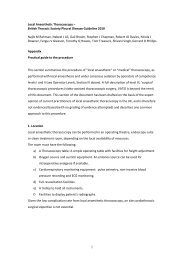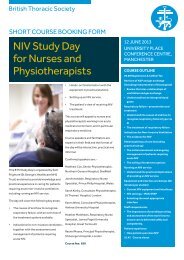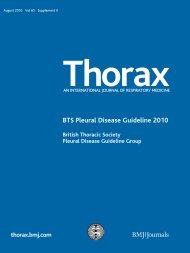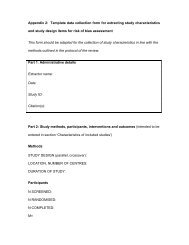Guidelines for the management of community ... - Brit Thoracic
Guidelines for the management of community ... - Brit Thoracic
Guidelines for the management of community ... - Brit Thoracic
Create successful ePaper yourself
Turn your PDF publications into a flip-book with our unique Google optimized e-Paper software.
BTS guidelines<br />
Figure 2 Synopsis <strong>of</strong> <strong>the</strong> <strong>management</strong><br />
<strong>of</strong> adult patients seen in hospital with<br />
suspected <strong>community</strong> acquired<br />
pneumonia, with cross reference to<br />
relevant sections in <strong>the</strong> document text.<br />
1.3.2 Defining <strong>the</strong> terms ‘‘atypical pneumonia’’ and ‘‘atypical<br />
pathogens’’<br />
The term ‘‘atypical pneumonia’’ has outgrown its historical<br />
usefulness and we do not recommend its continued use as it<br />
implies (incorrectly) a distinctive clinical pattern (see Section<br />
4.2).<br />
For <strong>the</strong> purposes <strong>of</strong> <strong>the</strong>se guidelines, <strong>the</strong> term ‘‘atypical<br />
pathogens’’ is used to define infections caused by:<br />
c Mycoplasma pneumoniae;<br />
c Chlamydophila pneumoniae;<br />
c Chlamydophila psittaci; and<br />
c Coxiella burnetii.<br />
These pathogens are characterised by being difficult to<br />
diagnose early in <strong>the</strong> illness and are sensitive to antibiotics<br />
o<strong>the</strong>r than b-lactams such as macrolides, tetracyclines or<br />
fluoroquinolones which are concentrated intracellularly, which<br />
is <strong>the</strong> usual site <strong>of</strong> replication <strong>of</strong> <strong>the</strong>se pathogens. As such, we<br />
conclude that <strong>the</strong> term ‘‘atypical pathogens’’ is still useful to<br />
clinicians in guiding discussion about aetiology and <strong>management</strong><br />
<strong>of</strong> CAP.<br />
iii8<br />
Legionella spp, although sharing some <strong>of</strong> <strong>the</strong>se characteristics,<br />
are not considered to be an ‘‘atypical pathogen’’ <strong>for</strong> <strong>the</strong> purpose<br />
<strong>of</strong> this document as <strong>the</strong>re are different species and <strong>the</strong>se can be<br />
acquired both in <strong>the</strong> <strong>community</strong> and hospital environment.<br />
1.3.3 Defining <strong>the</strong> term ‘‘elderly’’<br />
There is no agreed age cut-<strong>of</strong>f to define <strong>the</strong> term ‘‘elderly’’.<br />
When referring to published research, wherever possible we<br />
define <strong>the</strong> age limits used in <strong>the</strong> relevant studies.<br />
1.4 What is <strong>the</strong> target end user audience?<br />
We want <strong>the</strong>se guidelines to be <strong>of</strong> value to:<br />
c Hospital-based medical and o<strong>the</strong>r staff involved with<br />
managing adult patients with CAP.<br />
c General practitioners.<br />
c Those teaching about <strong>the</strong> subject at both undergraduate and<br />
postgraduate level.<br />
The guidelines have been developed to apply to <strong>the</strong> UK<br />
healthcare system and population, but <strong>the</strong>y might also be <strong>of</strong><br />
value to o<strong>the</strong>r countries which operate similar healthcare<br />
Thorax 2009;64(Suppl III):iii1–iii55. doi:10.1136/thx.2009.121434


